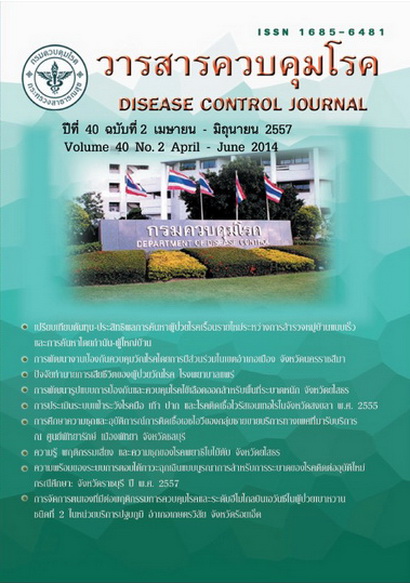Preparedness of integrated emergency response system for emerging infectious diseases, A case study of Ratchaburi Province, 2014
DOI:
https://doi.org/10.14456/dcj.2014.24Keywords:
emerging infectious diseases, integrated emergency response systemAbstract
This survey research was conducted to study the preparedness of Ratchaburi province in responding to emergency situations arising from outbreaks of emerging infectious diseases (EIDs) and to suggest issues for improvement. Findings would be used as examples in strengthening such preparedness in other provinces. Twenty-six executives and staff of the province were interviewed and twenty-four places were visited and surveyed using a questionnaire and a survey form which were constructed based upon given criteria of the preparedness. Data were collected during September 2013 to March 2014 and analyzed using descriptive statistics of frequency and percentage. Results were discussed in a group of experts to get consolidated feedback and recommendations. Ratchaburi province was found to have adequate preparedness for emergency response with regard to EIDs according to the given criteria; however, three issues for improvement were identified. The first one was about system integration where official appointments had not been made for the Surveillance and Rapid Response Teams (SRRTs) responsible for the investigation of relevant human and animal- disease outbreaks, the Steering Committee and the Operation Center for the prevention and care of avian and pandemic influenza and EIDs. Table-top exercises had not been conducted regularly and in the current year. The second issue was about management where some essential elements of the provincial information center and the information and surveillance systems among humans and animals on EIDs and respiratory infectious diseases including Influenza were missing. Guidelines on stockpiling and replenishment of pharmaceuticals, vaccines and medical equipment to health care facilities were not available. The third issue was on livestock development where animal husbandry models, human resource development and knowledge transfer were yet to be fully covered among target groups.The district level analysis revealed that 8 out of 10 districts had fulfilled the given preparedness criteria and two issues for improvement were noted. The first one was about system integration where a specific Steering Committee for the prevention and control of EIDs and respiratory infectious diseases including Influenza was yet to be established while the Committee for the prevention of nosocomial infections had not been updated for the current year. The second one was on managerial aspect where the influenza vaccine coverage among high risk groups was lower than the target. Numbers of influenza patients visiting hospitals had not been taken into account in the planning for and stockpiling of antivirals. Three outstanding findings on development of the preparedness in Ratchaburi during the past 8 years were noted. The first one was about the development on management of Avian and Pandemic Influenza outbreak response, comprising the establishment of an operation center with clear incident command system. The second one was the creation of a model and curriculum for simulate exercise, especially the prototype of a field hospital. Lastly, the improvement and strengthening of surveillance network in this province was awarded a national first prize in 2013. Three important recommendations were made. Firstly on system integration, a provincial steering committee should be established to oversee the response to emergency situations related to diseases and health hazards. The committee should have the ability to handle the changing situation in the province whereas exercises and reviews of its event command system should be conducted annually. Secondly on managerial aspect, of human resource development should be supported regarding the essential knowledge, competency and skills in adjusting work systems as we exercise curriculum. Lastly on operational aspect, district and sub-district models of preparedness and operational procedures for emergency response should be harmonized and regularly communicated and linked with the provincial health office.
Downloads
References
2. สำนักระบาดวิทยา กรมควบคุมโรค. สถานการณ์โรคไข้หวัดใหญ่ 2009 [อินเทอร์เน็ต]. [สืบค้นเมื่อ 21 พ.ย. 2555]. แหล่งข้อมูล: http://www.boe.moph.go.th/files/ report/20121120_ 87267959.pdf
3. สำนักโรคติดต่ออุบัติใหม่ กรมควบคุมโรค. แผนยุทธศาสตร์เตรียมความพร้อมป้องกันและแก้ไขปัญหาโรคติดต่ออุบัติใหม่แห่งชาติ (พ.ศ. 2556- 2559). กรุงเทพมหานคร: โรงพิมพ์ชุมนุมสหกรณ์การเกษตรแห่งประเทศไทย; 2555.
4. สำนักโรคติดต่ออุบัติใหม่ กรมควบคุมโรค. การฝึกซ้อมแผนชนิดบนโต๊ะ (Tabletop Exercise) เพื่อเตรียมความพร้อมสำหรับการระบาดใหญ่ของโรคไข้หวัดใหญ่ระดับจังหวัด สำหรับผู้จัดการฝึกซ้อมและวิทยากร พ.ศ. 2553. กรุงเทพมหานคร: โรงพิมพ์ชุมนุมสหกรณ์การเกษตรแห่งประเทศไทย; 2553.
5. ศูนย์ปฏิบัติการตอบโต้ภาวะฉุกเฉินทางสาธารณสุข กรมควบคุมโรค. คู่มือตอบโต้ภาวะฉุกเฉินทางสาธารณสุขของศูนย์บัญชาการส่วนกลางและส่วนภูมิภาค. กรุงเทพมหานคร: นำอักษรการพิมพ์; 2551.
6. สำนักโรคติดต่ออุบัติใหม่ กรมควบคุมโรค กระทรวงสาธารณสุข. คู่มือการเรียนรู้ด้วยตนเอง เรื่อง การจัดทำแผนประคองกิจการภายในองค์กร เพื่อเตรียมความพร้อมสำหรับการระบาดใหญ่ของโรคไข้หวัดใหญ่ ปี พ.ศ. 2552. กรุงเทพมหานคร: โรงพิมพ์ชุมนุมสหกรณ์การเกษตรแห่งประเทศไทย; 2552.
Downloads
Published
How to Cite
Issue
Section
License
Articles published in the Disease Control Journal are considered as academic work, research or analysis of the personal opinion of the authors, not the opinion of the Thailand Department of Disease Control or editorial team. The authors must be responsible for their articles.






